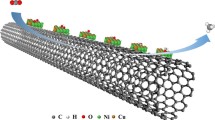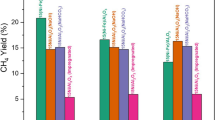Abstract
Catalytic chemical vapor deposition (CVD) is a popular method to synthesize carbon nanotubes (CNTs). At the presence of catalysts (usually trasition metals), the hydrocarbon feedstock decomposes controllably at elevated temperatures and can form tubular structures. It has been suggested that trace amounts of weak gas-phase oxidants, such as CO2, can enhance the CNT synthesis by extending the catatlyst life. It is not clear, however, how such additives affect the CVD reaction environment. In this study, ethylene gas was introduced to a preheated furnace/CVD reactor where meshes of stainless steel were placed. Therein ethylene was thermally decomposed in nitrogen mixed with different amounts of carbon dioxide. The meshes served as catalytic substrates for the CNT growth. The compositions of the ethylene pyrolyzates were analysed both with and without the presence of catalysts, to explore the possible contributions of CO2 addition to the CNT formation. The latter compositions were compared with kinetic model predictions of the thermal decomposition of ethylene. Both experimental and simulation results indicated that 1,3-butadiene (C4H6) was the most abundant hydrocarbon species of ethylene decomposition (at 800 °C) and that decomposition was inhibitted at the presence of CO2. A commesurate effect on CNT formation was observed experimentally, whereas the quality of CNTs got improved.
Similar content being viewed by others
References
Hata K., {etet al.}, Water-Assisted Highly Efficient Synthesis of Impurity-Free Single-Walled Carbon Nanotubes. Science, 2004. 306(5700): p. 1362–1364.
Li G., {etet al.}, The effect of substrate positions in chemical vapor deposition reactor on the growth of carbon nanotube arrays. Carbon, 2010. 48(7): p. 2111–2115.
Wen Q., {etet al.}, 100 mm Long, Semiconducting Triple-Walled Carbon Nanotubes. Advanced Materials, 2010. 22(16): p. 1867–1871.
Huang J.Q., {etet al.}, Process Intensification by CO2 for High Quality Carbon Nanotube Forest Growth: Double-Walled Carbon Nanotube Convexity or Single-Walled Carbon Nanotube Bowls? Nano Research, 2009. 2(11): p. 872–881.
Corthals S., {etet al.}, The beneficial effect of CO2 in the low temperature synthesis of high quality carbon nanofibers and thin multiwalled carbon nanotubes from CH4 over Ni catalysts. Carbon, 2012. 50(2): p. 372–384.
Wen Q., {etet al.}, CO2-Assisted SWNT Growth on Porous Catalysts. Chemistry of Materials, 2007. 19(6): p. 1226–1230.
Chen M., {etet al.}, Influence of CO2 and N2 on the growth of carbon nanotubes by using thermal chemical vapor deposition. Thin Solid Films, 2007. 516(2–4): p. 277–283.
Li Z., {etet al.}, CO2 enhanced carbon nanotube synthesis from pyrolysis of hydrocarbons. Chemical Communications, 2008(28).
Yang X.S., {etet al.}, Open-Ended Aligned Carbon Nanotube Arrays Produced Using CO2-Assisted Floating-Ferrocene Chemical Vapor Deposition. Journal of Physical Chemistry C, 2011. 115(29): p. 14093–14097.
Magrez A., {etet al.}, Evidence of an Equimolar C2H2–CO2 Reaction in the Synthesis of Carbon Nanotubes. Angewandte Chemie International Edition, 2007. 46(3): p. 441–444.
Magrez A., {etet al.}, Low-Temperature, Highly Efficient Growth of Carbon Nanotubes on Functional Materials by an Oxidative Dehydrogenation Reaction. ACS Nano, 2010. 4(7): p. 3702–3708.
Magrez A., {etet al.}, Catalytic CVD Synthesis of Carbon Nanotubes: Towards High Yield and Low Temperature Growth. Materials, 2010. 3(11): p. 4871–4891.
Gaiktwad A.V., {etet al.}, Carbon nanotube/carbon nanofiber growth from industrial by-product gases on low- and high-alloy steels. Carbon, 2012. 50(12): p. 4722–4731.
Li Z.R., {etet al.}, CO2 enhanced carbon nanotube synthesis from pyrolysis of hydrocarbons. Chemical Communications, 2008(28): p. 3260–3262.
Faravelli T., {etet al.}, Gas product distribution from polyethylene pyrolysis. Journal of Analytical and Applied Pyrolysis, 1999. 52(1): p. 87–103.
Williams P.T. and Williams E.A., Fluidised bed pyrolysis of low density polyethylene to produce petrochemical feedstock. Journal of Analytical and Applied Pyrolysis, 1999. 51(1–2): p. 107–126.
Mastellone M.L., {etet al.}, Fluidized bed pyrolysis of a recycled polyethylene. Polymer Degradation and Stability, 2002. 76(3): p. 479–487.
Mastral F.J., {etet al.}, Pyrolysis of high-density polyethylene in a fluidised bed reactor. Influence of the temperature and residence time. Journal of Analytical and Applied Pyrolysis, 2002. 63(1): p. 1–15.
Costa P.A., {etet al.}, Kinetic evaluation of the pyrolysis of polyethylene waste. Energy & Fuels, 2007. 21(5): p. 2489–2498.
Zhuo C., {etet al.}, Oxidative heat treatment of 316L stainless steel for effective catalytic growth of carbon nanotubes. Applied Surface Science, 2014(0).
Ruiz M.P., {etet al.}, Soot formation from C2H2 and C2H4 pyrolysis at different temperatures. Journal of Analytical and Applied Pyrolysis, 2007. 79(1–2): p. 244–251.
Brüggert M., Hu Z., and Hüttinger K.J., Chemistry and kinetics of chemical vapor deposition of pyrocarbon: VI. influence of temperature using methane as a carbon source. Carbon, 1999. 37(12): p. 2021–2030.
Acknowledgment
Financial support for this study was provided by the Department of Mechanical and Industrial Engineering in Northeastern University, and by the Akira Yamamura Fellowship to Chuanwei Zhuo. Chuanwei Zhuo thanks Mr. William Fowle for SEM support and Mr. Fangze Liu for Raman spectra support.
Author information
Authors and Affiliations
Rights and permissions
About this article
Cite this article
Zhuo, C., Khanshan, F., West, R. et al. Effects of CO2 on Carbon Nanotube Formation from Thermal Decomposition of Ethylene. MRS Online Proceedings Library 1747, 13–18 (2014). https://doi.org/10.1557/opl.2015.338
Published:
Issue Date:
DOI: https://doi.org/10.1557/opl.2015.338




